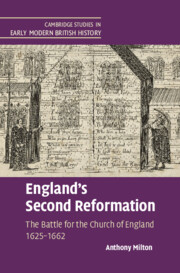Book contents
- England’s Second Reformation
- Cambridge Studies in Early Modern British History
- England’s Second Reformation
- Copyright page
- Dedication
- Contents
- Acknowledgements
- Abbreviations
- Introduction
- Chapter 1 An Unresolved Reformation
- Chapter 2 Situating the Laudian Reformation
- Chapter 3 Responses to the Laudian Reformation
- Chapter 4 The Abortive Reformation, 1640–1642
- Chapter 5 The End of Episcopalian Reformation
- Chapter 6 Reformation by Negotiation
- Chapter 7 The Westminster Reformation and the Parliamentarian Church of England
- Chapter 8 The Royalist Church of England, 1642–1649
- Chapter 9 Alternative Reformations, 1649–1653
- Chapter 10 The Cromwellian Church
- Chapter 11 Episcopalian Royalism in the 1650s
- Chapter 12 Failed Reformations, 1659–1661
- Chapter 13 The End of Comprehensive Reformation and the Caroline Settlement
- Conclusion
- Index
Chapter 2 - Situating the Laudian Reformation
Published online by Cambridge University Press: 05 October 2021
- England’s Second Reformation
- Cambridge Studies in Early Modern British History
- England’s Second Reformation
- Copyright page
- Dedication
- Contents
- Acknowledgements
- Abbreviations
- Introduction
- Chapter 1 An Unresolved Reformation
- Chapter 2 Situating the Laudian Reformation
- Chapter 3 Responses to the Laudian Reformation
- Chapter 4 The Abortive Reformation, 1640–1642
- Chapter 5 The End of Episcopalian Reformation
- Chapter 6 Reformation by Negotiation
- Chapter 7 The Westminster Reformation and the Parliamentarian Church of England
- Chapter 8 The Royalist Church of England, 1642–1649
- Chapter 9 Alternative Reformations, 1649–1653
- Chapter 10 The Cromwellian Church
- Chapter 11 Episcopalian Royalism in the 1650s
- Chapter 12 Failed Reformations, 1659–1661
- Chapter 13 The End of Comprehensive Reformation and the Caroline Settlement
- Conclusion
- Index
Summary
‘Laudianism’ was not simply a different perspective on the Church of England’s identity from that held by other English Protestants, but a systematic attempt to impose a particular reading of the English Church on all parishes, and to privilege and prioritize certain facets and formularies over others. This chapter focuses on how the Laudians chose to situate their reforms vis-à-vis the earlier history and formularies of the Church of England. Like the Protestant Reformation itself, the Laudian Reformation framed itself as the repudiation of an impure present, and as a return to a more pure or ‘primitive church’ that had existed before the current abuses had taken hold. However, the chapter argues that the identity of that ‘primitive church’ was subject to constant change. It demonstrates how different Laudian authors found elements of the Jacobean church and Elizabethan settlement wanting, and instead selectively appropriated and sampled elements from earlier reformations, and from the medieval and patristic churches. For all their often conservative rhetoric, the chapter also explores the Laudian readiness to promote a language of progressive reformation and revelation, and to seek to change existing structures and formularies where possible.
Keywords
- Type
- Chapter
- Information
- England's Second ReformationThe Battle for the Church of England 1625–1662, pp. 34 - 67Publisher: Cambridge University PressPrint publication year: 2021

